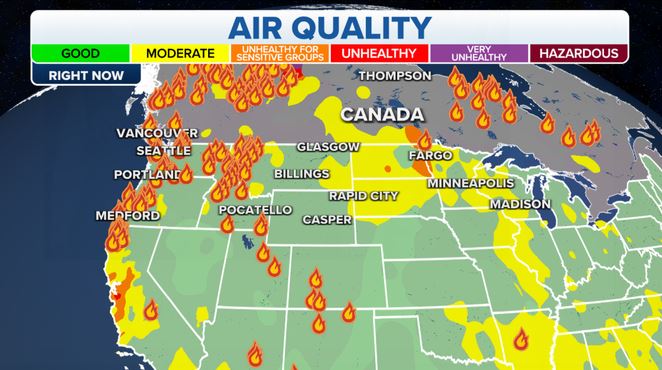Wildfires in Northern California and Oregon Worsen Air Quality Crisis in San Francisco Bay Area

Severe air quality issues in the San Francisco Bay Area are exacerbated by smoke from ongoing wildfires in Northern California and Oregon, leading to health advisories and concerns, as well as highlighting the significance of understanding the Air Quality Index (AQI) during wildfire events. (Photo: foxweather)
Impact of Wildfires in Northern California and Oregon on San Francisco Bay Area’s Air Quality
According to usatoday.com, the San Francisco Bay Area is currently grappling with severe air quality issues caused by smoke from the ongoing wildfires in Northern California and Oregon. The Bay Area Air Quality Management District has issued an advisory for Tuesday and Wednesday warning residents about smoky and hazy conditions in various parts of the region.
Health officials are urging people who smell smoke to stay indoors, close windows and doors, and use air conditioning and car ventilation systems to keep outdoor air contaminated by the wildfires in Northern California and Oregon, out of their homes and vehicles. Additionally, the National Weather Service has declared a fire-weather watch for parts of the interior North Bay, heightening concerns about the wildfire situation.
San Francisco’s alarming ranking as the most polluted major city globally on Tuesday evening underscores the seriousness of the issue. The Department of Emergency Management has categorized San Francisco’s air quality as unhealthy, especially advising those with respiratory problems, including children and adults, to limit outdoor activities due to the impact of the wildfires in Northern California and Oregon.
READ ALSO: Losing Health Insurance — Coloradans Ranks 15th for Highest Rate of Losing Medicaid
Understanding the Air Quality Impact of Wildfires in Northern California and Oregon
To grasp the significance of the air quality situation, it’s essential to understand the Air Quality Index (AQI). The AQI, measured on a scale from 0 to 500, reflects the severity of air pollution and health concerns, influenced by factors such as the wildfires in Northern California and Oregon.
The Environmental Protection Agency (EPA) calculates AQI values based on five major air pollutants regulated by the Clean Air Act, including ground-level ozone, particulate matter, carbon monoxide, sulfur dioxide, and nitrogen dioxide, with ground-level ozone and airborne particles posing the greatest health risks.The AQI is categorized into six levels, ranging from “good” to “hazardous,” represented by different colors. When AQI values stay at or below 100, air quality is generally considered satisfactory.
However, as the AQI surpasses 100, it signifies unhealthy conditions, affecting sensitive groups first and eventually impacting everyone, particularly during events like the wildfires in Northern California and Oregon. Understanding the AQI is crucial for individuals to assess and respond to air quality, especially during periods influenced by wildfires and similar environmental factors.
READ ALSO: Why are Retirees in Florida Fleeing the State? Here is the Reason Why









